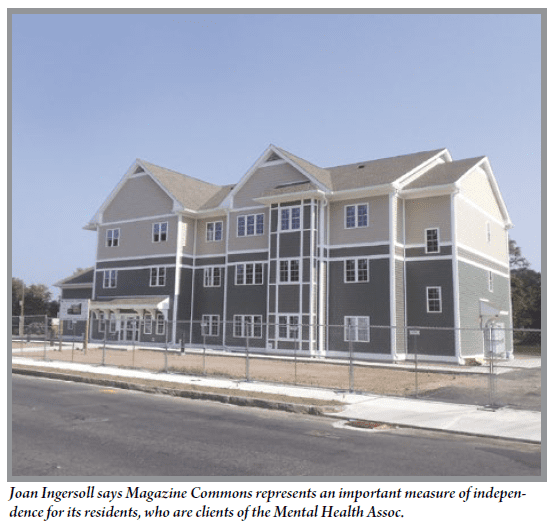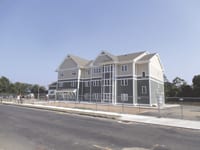Peace of Mind – Magazine Commons Gives Tornado-scattered Residents a Fresh Start
When an apartment complex owned by the Springfield-based Mental Health Assoc. was destroyed in the 2011 tornado that touched down in the city’s South End — displacing 14 MHA clients who lived there — the architects at Studio One certainly empathized, because their offices were wrecked as well.
“We really could relate,” said Christopher Novelli, one of those architects. “These people lost their homes. It’s an emotional experience. We lost our office, and Greg Zorzi, our principal, had an apartment above our office, so he lost his home as well.”
So Zorzi and his team took plenty of satisfaction in designing Magazine Commons, the new, 16-unit apartment building on Magazine Street that replaces the former residential complex on Union Street. The new structure, set to open in November, was built next to the MHA’s headquarters on Worthington Street, in the city’s McKnight district, on a formerly blighted parcel.

“We had a building on Union Street that we’d operated for 30 years, but it was completely destroyed,” said Joan Ingersoll, president and CEO of the MHA, which provides residential and support services that promote independence, community engagement, and wellness for people impacted by mental illness, developmental disabilities, substance abuse, homelessness, and other challenges. “The people scattered; some relocated in other towns, and others stayed in Springfield.”
Several will be returning this fall to Magazine Commons, which is a success story on multiple levels, said Novelli, referring to its importance to the MHA and also its development on a brownfield site the city had been anxious to clean up for some time.
“There were contaminated soils, and it was unusable for building,” Novelli said. “The city owned it for years and issued several RFPs, but there were no takers on the property. Finally, the MHA came in.”
For this issue, HCN talked with Novelli and Ingersoll about how the $4.6 million project came together, and how the new building will improve the lives of its tenants.
Home Again
In the aftermath of the tornado, residents of the destroyed complex dispersed to temporary housing, Ingersoll said, but, four years later, the MHA had no problem filling the 17,000-square-foot Magazine Commons with former Union Street residents as well as new clients.
“Some people are moving in from a group home, so this is their first opportunity to live independently,” she noted. “Some already live independently, so this is a different opportunity for them; they’re excited to move in. A couple of people had been in and out of different places and had periods of homelessness, and this is brand-new, stable housing.”
Darnella Johnson, one of the individuals preparing to move in, told HCN she expects it to be comfortable and safe, and appreciated its proximity to a bus line — an amenity Ingersoll said is important to clients seeking to hold down employment.
Vincent Littlejohn is one of those. “I’m looking to get a job, and living close to a bus line will help me get to a job and my [support-group] meetings,” he said, noting that he, like Johnson, is currently living in a group home and is looking forward to a new measure of independence once interior construction is complete.
The facility, built by N.L. Construction in Ludlow, includes four apartments on the first floor and six apartments each on the second and third floors. The design also includes common space as well as office space for MHA staff.

“It has a community room for skill-building opportunities like cooking lessons, classes, and gatherings for social opportunities,” Ingersoll explained. “The staff offices are on the first floor — but this is not a staffed residence; the staff are outreach staff. All the residents have a certain number of hours the staff spends with them on things they need assistance with — managing medications, going to doctor appointments, teaching them how to take public transportation, how to manage money. Some of the staff will have the building as their home base, but they don’t sleep there.”
Novelli said the interior design reflects the needs of people who live independently but still face challenges.
“The people that will live there are all capable of self-preservation, all capable of living on their own. It’s not an assisted-living facility,” he explained. “There is some extra reinforcement in the bathrooms and some higher-durability finishes — rather than using carpet, it’s all tile in the living room, so it cleans up easily.”
Another challenge was fitting the building’s exterior into the historical context of the McKnight neighborhood — typically a priority for Studio One, which has plenty of experience designing housing complexes.
“We did a study of existing housing sites, and didn’t want to replicate them,” said Novelli. “But we wanted to make sure it fit in, as far as the exterior detailing, the massing of the building, and the proportions. We had several neighborhood meetings with people in the McKnight district.
“Some of the items in the original design were cut due to budget, but we were able to keep most of the proportions they wanted,” he went on. “All 16 are one-bed units, 550 square feet with large kitchens that open to living rooms.”
Studio One’s design also complied with — and in many cases exceeded — the city’s stretch codes, which mandate strict standards for energy efficiency, he added.
“We’re going beyond that with highly efficient mechanical systems, the building envelope, and thermal details,” he said, noting that such codes are becoming industry standard in many types of buildings, just as homeowners and developers are increasingly understanding the eventual cost savings. “The main concern has always been the bottom line rather than the long term. But people are starting to realize that, if you invest money at the start, you end up saving more money.”
Community Asset
Ingersoll was quick to note that Magazine Commons represents not just a housing complex, but a $4.6 million investment in the neighborhood, including sidewalks, lighting, neighborhood stabilization, and brownfield development. And it’s not an investment in just 16 current residents, but for dozens, even hundreds more over the coming decades, all of whom are trying to get to a more secure place in life, she added.
The MHA’s development team presented the plans to the McKnight Neighborhood Council in April of 2013, at which time the council voted to support it. The project has received financial support from the city of Springfield, the state Department of Housing and Community Development, the Mass. Community Development Assistance Corp., the state Department of Mental Health, MassDevelopment, the Affordable Housing Program of the Federal Home Loan Bank of Boston, and People’s United Bank.
With about $2 million in insurance money in hand from the tornado, the multiple funding partnerships meant the MHA had to finance only about $750,000 of the overall cost. Designated a HUD 202 project for people with disabilities, the apartments are subsidized, with residents paying no more than 30{06cf2b9696b159f874511d23dbc893eb1ac83014175ed30550cfff22781411e5} of their income and HUD picking up part of the rental cost, Ingersoll noted.
“HUD told us we could rebuild in Springfield when we got the subsidies transferred over to the new project,” she explained. “We’ve been working with the city since then to identify and agree on the land, which was, fortunately, right next door to our main offices. The land was a pretty big parcel, but it was blighted and needed cleanup. We bought it for a dollar from the city, and we were able to revitalize the whole block.”
Novelli said the design included a specialized foundation system called a geo-pier, which densifies soil underneath a structure, so it can be built on what otherwise would be considered unsuitable soil.
Despite the challenges — or perhaps because of them — he and Zorzi are gratified to help the MHA rebuild a key component of its services. Founded in 1960, the agency operates 21 sites throughout Greater Springfield and serves more than 400 people annually through its residential and outreach programs.
Magazine Commons will be staffed weekdays from 8 a.m. to 8 p.m., making the location next to MHA headquarters ideal for both residents and staff, Ingersoll added.
“It’s pretty unbelievable for the people moving in there,” she told HCN. “I’ve had the opportunity to go in with some clients for the first time. When they see it, they become so excited. They think the units are beautiful. It’s a great opportunity for them.”
After all, she added, good housing is often a critical step in helping people procure good jobs and a brighter future. “It’s often the foundation for everything else in life.”


Comments are closed.